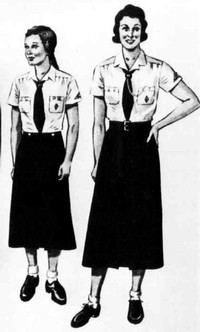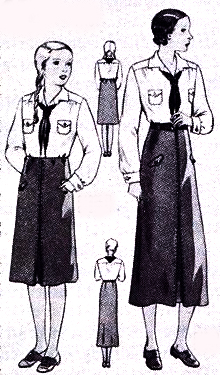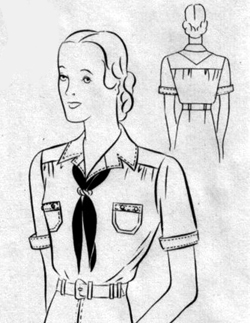Introduction
 Just like the boys and young men of the male Hitler Youth, the girls in the Jungmaedel and the League of German Girls had to wear a service uniform at all meetings and any other official functions they attended.
Just like the boys and young men of the male Hitler Youth, the girls in the Jungmaedel and the League of German Girls had to wear a service uniform at all meetings and any other official functions they attended.
The basic uniform, which we will consider to be the “summer uniform” for the purpose of this website, consisted of a dark blue skirt, a white blouse, and a black neckerchief.
This uniform was to be worn to any functions the League of German Girls participated in, such as parades and events, but also to all meetings of the League, as well as on trips and outings. Wearing your uniform outside of special occasions was originally not allowed, but it soon became commonplace for members of the BDM to wear their uniforms to school. Some teachers who were party members often preferred girls who were active in the BDM over their other students and gave them better grades, while they admonished girls who weren’t members or were not very active in their service.
Because parents had to purchase the uniform for their daughters, it was not uncommon that a girl joined, but her parents either refused to or could not afford to buy her the complete uniform. Especially the climbing jacket was not always well-received by parents and many former members recounted that they never owned one and wore a trachten sweater or their regular “civilian” jackets instead.
In many instances where parents could not afford to purchase the uniform, they were home-made from approved patterns sold at clothing stores in the towns, such as ABC Schnitt or Lutterloh. Or else they were substituted by using clothing that “looked right”, such as a regular white blouse and blue skirt. This was especially common among younger members in the Jungmaedel because it was expensive to buy new uniforms each time a girl grew out of them. If a family had several daughters, uniforms were often handed down to younger siblings. This accounts for a lot of variations in styles, colors, and fit among the BDM uniforms that we see in photos and especially on the collector’s market.
The White Shirt
The uniform blouse of the League of German Girls, which is seen in the period drawing from a pattern set seen on the right, consisted of a short-sleeved white blouse with two patch pockets. It was designed to be worn with the collar folded down, and the use of the neck yoke and pleats along the edge of the yoke in back and front allowed for easy movement.
The blouses are most commonly seen with the open patch pockets pictured on the right, but a variation that had a flap and closed with just one button is also commonly seen in period photos (and on period patterns.)
A long-sleeved version of the blouse was meant to be worn underneath the jacket in winter.
The blouse was made of poplin, Natté, or Panama fabric (a type of worsted wool or cotton) and was worn over a white undershirt or over the sports shirt. For younger girls of the Jungmaedel, the waistline of the blouse had buttons so that it could be buttoned into button holes on the blue skirt. This allowed for a comfortable fit on little girls who did not yet show a real “waist” and allowed for free movement.
Because parents had to purchase the uniforms, many of them felt that a simple white blouse that their daughter already owned made a good substitute for the official BDM blouse. This was especially often the case with the younger girls in the Jungmaedel, who were still growing which meant that her parents had to purchase a new uniform each time she’d outgrown the old one – which got expensive over the years. This is why, in so many period photographs, we see a huge variation of blouses with different pocket and sleeve styles, different cuts and different collars.
Buttons on the official BDM blouse were white in color and bore the letters “BDM” as well as “JM” on them, as well as little oak leaves, as can be seen in the photo on the right. (Please note that the color of the button on the right looks yellow – this is due to the fact that I adjusted the photo in order to bring out the embossed letters. The actual buttons were white.) Button materials varied and buttons made from a plastic-like material called bakelite were most common. Buttons were available in two different sizes – large ones for buttoning into the skirts, and a smaller diameter button for the front closure and pockets.
 BDM blouses sold at the “Brauner Laden” (the “Brown Store”, a specialty store that sold party uniforms, uniform parts, and insignia) were also available in colors other than white. A former member recalls that they were sold in grey, brown, dark blue, and light blue. These were to be worn for “special work” assignments where the official white blouse wasn’t allowed to be worn for whatever reason.
BDM blouses sold at the “Brauner Laden” (the “Brown Store”, a specialty store that sold party uniforms, uniform parts, and insignia) were also available in colors other than white. A former member recalls that they were sold in grey, brown, dark blue, and light blue. These were to be worn for “special work” assignments where the official white blouse wasn’t allowed to be worn for whatever reason.
The Blue Skirt

The official uniform skirt of the League of German Girls can be seen in the drawing on the left which came from a clothing catalog of that time period. The skirt was a long, dark blue wool skirt that featured a center pleat in front and two covered pockets. It was generally between knee length to mid-calf length, depending on the current fashions of that year.
The skirt was to be made from “BDM-Rockstoff” (BDM skirt material), type I or type II, which was sold at fabric stores. The real BDM skirt material had a stamp of the lettering “BDM” on the wrong side of the material. The inside of the waist band and pockets were made of dark grey cotton twill.
The skirts for the young girls of the Jungmaedel who had not yet fully developed their feminine shapes had a row of button holes at the top that the blouse buttoned into. This was done so that the skirt wouldn’t be constricting and allow for comfortable movement.
The BDM skirt for older girls had a 4 centimeter wide black elastic band at the waist to help with a comfortable fit. In addition, they also wore a black leather belt with a plain silver open-faced buckle, which was pulled through loops at the skirt waist.
Because the skirts were a very dark blue color, many researchers assume that the skirts were black because the color cannot be established from period black and white photos, or even most of the period color film footage. Another reason many researchers think the skirts were black is that the buttons on the skirts are described as “black BDM buttons” in period manuals.
Because the skirt did not have a liner of any kind, it was usually worn over a regular slip. The skirt was worn both during the summer as well as during the winter and no special “winter” skirt existed – girls simply wore long undershirts and thigh-high wool stockings to keep warm.
Skirt closures varied with manufacture. Official manufacturing guidelines describe a snap-closure with a hook-and-loop closure at the waist, while some photos show metal zippers or buttons.
Since not all parents could afford to purchase the regulation skirt for their daughters, especially if the girl was still growing and a new one would have to be bought every year, we frequently see variations of the skirts, although they are not as common as variations of the white blouse. A lot of the time, skirts were homemade by mothers using approved “regulation” patterns and instructional booklets that were sold at local department stores, and these homemade skirts weren’t always made from the “regulation uniform fabrics” sold at stores. Thus we sometimes see BDM skirts in cotton, or linen, whereby the choice of fabric was determined by what was most available or affordable.
The Neckerchief and Leather Slide
 To complete the uniform, girls wore a black neckerchief called the Fahrtentuch, which was triangular in shape and fairly large. The neckerchief was made of a light-weight brushed cotton, which has a slight sheen to it, and was worn rolled up in a way so that only a small black triangle showed from underneath the collar in the back. It was worn underneath the shirt collar and held together in front using a woven leather knot, such as the one pictured on the right.
To complete the uniform, girls wore a black neckerchief called the Fahrtentuch, which was triangular in shape and fairly large. The neckerchief was made of a light-weight brushed cotton, which has a slight sheen to it, and was worn rolled up in a way so that only a small black triangle showed from underneath the collar in the back. It was worn underneath the shirt collar and held together in front using a woven leather knot, such as the one pictured on the right.
New members of the Jungmaedel who joined at the age of 10 (or eleven, if they were small for their age) officially received their neckerchief and slide during the Jungmaedel Confirmation event held each year on October 2nd. October 2nd was chosen in commemoration of the National Youth Congress of Potsdam in 1932. Both the leather knot and the neckerchief of the League of German Girls were identical to those of the male Hitler Youth. The color of the leather knot varied widely from a very light to very dark brown.
Just like today’s girl scouts, girls in the League also learned to use the neckerchief as a cravat or sling in their first aid training, which can be seen in some of the photos in the extensive BDM photo gallery of this website. Because of this, the dimensions of the BDM neckerchiefs are approximately the same as today’s cravat in the average first aid kit.
Shoes and Accessories

“The uniform is the accessory,” was the motto for members of the League of German Girls, and girls were discouraged from wearing any jewelry while they were in uniform.
This meant that earrings, necklaces, and rings were generally frowned upon – although there are some photos showing girls wearing small earrings, rings, or bracelets. Makeup was discouraged as well, especially for younger girls, but watches – useful and necessary – were, of course, allowed.
Worn with the uniform were a pair of black or brown lace-up shoes that also had to be purchased by the girls or her parents. The regulation shoes seen in the photo above were made of black leather and marked as official BDM shoes on the sole. Purchasing an optional horseshoe shaped metal plate for the heel and the front of the shoe was left up to the parents, but was encouraged so that the shoes made the “proper” sound while marching – few girls, however, used them or the regulation shoes.
With the exception of higher leaders who were expected to have the correct regulation uniform, girls were allowed to wear any kind of sturdy shoe with their uniform. While it was preferred that the shoes should be black in color and of the lace-up variety, many photos exist in which all sorts of shoes and sandals are worn. Worn with the shoes were white cotton anklets in summer and grey or brown wool stockings in winter.
Summer stockings, such as the back-seamed silk or Perlon stockings so commonly associated with the 1940s were not generally worn by BDM girls, and even on older leaders they are the exception.



